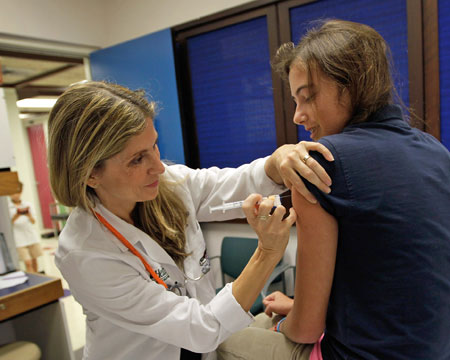NIH funds project to examine whether texts, games, Web portals can increase HPV vaccination rates
Sept. 24, 2014
Human papillomavirus (HPV), the most common sexually transmitted infection in the U.S., is known to cause various forms of cancer. Yet most HPV-associated cancers could be prevented with a vaccine that has been available since 2006.
Why, then, are parents not eager to immunize their preteens – as they do for measles and whooping cough – against HPV?

Immunizing 80 percent of girls currently 12 years old or younger against HPV would prevent an estimated 53,000 future cases of cervical cancer in women. Photo by NPR.
Finding out why that happens and what can be done to change it is the task of an interdisciplinary team of researchers that includes Gillings School of Global Public Health faculty members Justin Trogdon, PhD, visiting associate professor of health policy and management, and Jamie Crandell, PhD, research assistant professor of biostatistics.
“We want to raise awareness among parents and preteens about the availability and benefits of HPV vaccination,” said Joan R. Cates, PhD, MPH, faculty member in the UNC School of Journalism and Mass Communication, “and we want health care providers to be skilled in communicating with adolescents and parents about vaccination.”
Cates and her team from several disciplines at UNC and the Duke University Medical Center received a $2.4 million grant from the National Institutes of Health to use and evaluate methods like texts, games and Web portals for getting out the word about HPV and the vaccination to prevent it.
The team will work with 48 medical practices and nearly 500 parents and preteens in North Carolina over the next four years. The long-term goal is to prevent HPV-related disease through early intervention and protection.
Reaching the 80 percent national vaccination goal set by the U.S. Department of Health and Human Services for girls who are currently 12 years old or younger would prevent an estimated 53,000 future cases of cervical cancer in women. Meeting the vaccination goal for boys would prevent most of an estimated 7,500 HPV-associated cancers diagnosed in men every year.
The four-year grant project is funded by the National Institute of Allergy and Infectious Diseases in an effort to normalize preteen HPV vaccination and understand how doctors, parents and preteens respond to proactive health communication strategies that include text messaging and interactive Web tools that leverage social networks and mobile devices.
“It can be uncomfortable for doctors and parents to talk about vaccinating children against a sexually transmitted infection,” Cates said. “But it is critically important to vaccinate before exposure, so the preteen years are the ideal time to make sure people are protected from contracting the virus in the future.”
Cates and her colleagues are among the first researchers in the nation to focus on the issue from a communications perspective. Cates began working on the issue in 2009 with a social marketing campaign funded by the state of North Carolina. The campaign included print materials and broadcast public service announcements designed to raise awareness with parents and to facilitate communication among doctors, parents and preteens.
The new project uses the unique approach of proactive communication targeted and customized for each of the three different key communities around the issue – doctors, parents and preteens. It is an example of dissemination and implementation research that is increasingly recognized as critical in the fields of health research and practice.
Parents will view print materials and information through a dedicated Web portal to learn about HPV vaccination, see testimonials from other parents and enhance conversations about vaccination with their children. Preteens will be able to play age-appropriate, entertaining and informative Web-based games about vaccines. Doctors can use print and interactive materials to improve their conversations with parents and preteens, stay updated on a rapidly evolving field and share experiences with other providers.
“We will continually assess and refine our messaging and our tactics based on what we learn along the way,” Cates said. “One important outcome of this project will be the development of a cost-effective set of tools and guidelines to share widely with medical practices and bring the HPV vaccination campaign to larger scale.”
In addition to Cates, Trogdon and Crandell, project co-investigators include Tamera Coyne-Beasley, MD, MPH, professor in the departments of pediatrics and internal medicine, UNC School of Medicine; Sandra Diehl, MPH, research associate for the Community Engagement (CARES) unit within the North Carolina Clinical and Translational Sciences Institute at UNC; and Bernard Fuemmeler, PhD, associate professor in community and family medicine at Duke University and the director of mHealth@Duke. Crandell also is research associate professor in the UNC School of Nursing.
